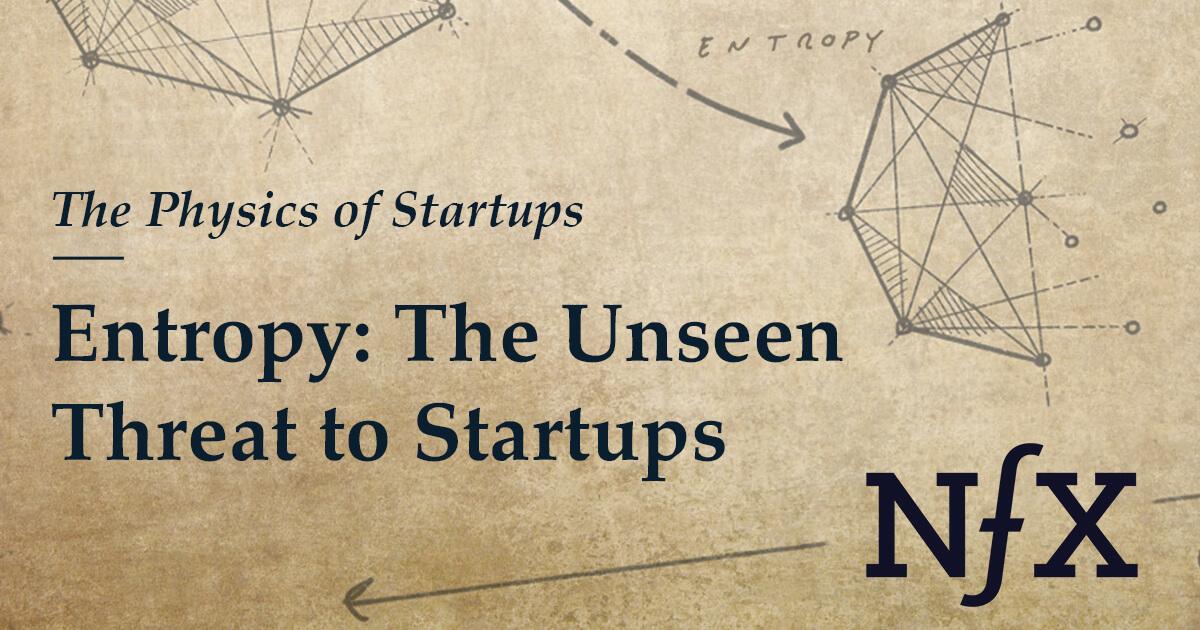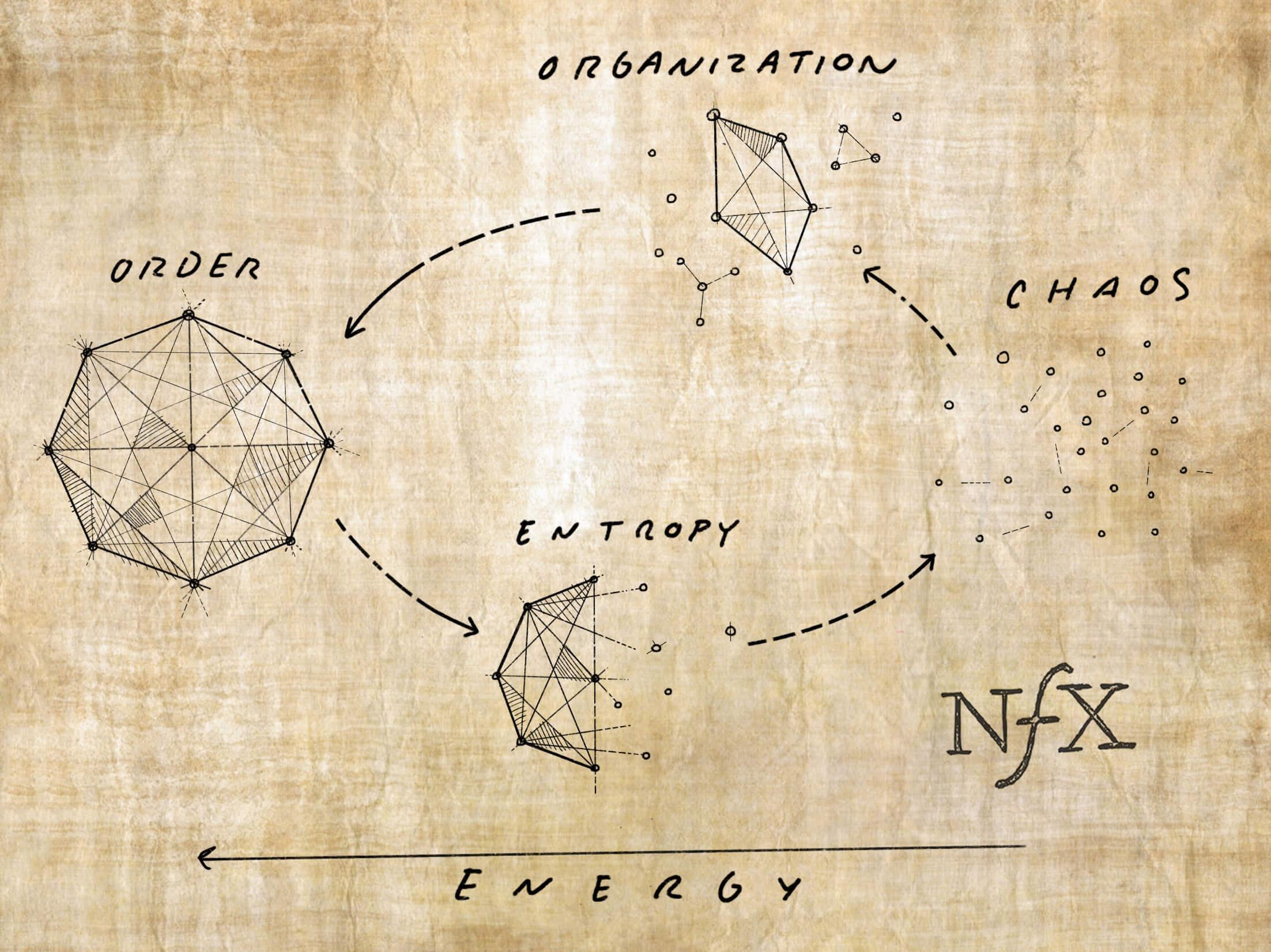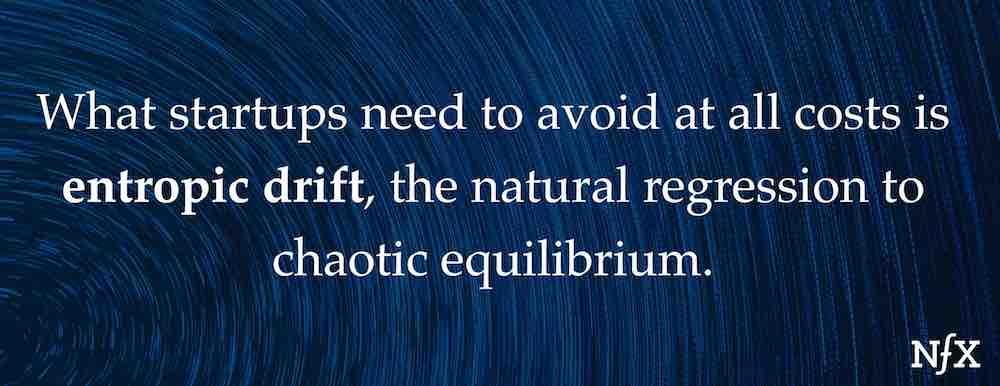

“Disorder, or entropy, always increases with time. In other words, it is a form of Murphy’s law: things always tend to go wrong!” – Stephen Hawking, A Brief History of Time
Why do apparently successful startups suddenly fail? We’ve all seen this happen on occasion, and to the untrained eye it’s hard to detect a pattern. When it happens it’s usually explained away as owing to a “lack of funding” or a “tough market”. But if you look closely at startups like these, you’ll see the internal chaos hidden beneath a well-ordered veneer.
We know from the second law of thermodynamics that closed systems tend towards a state of greater disorder unless acted upon from the outside. Entropy is the tendency of ordered systems to move towards disorder if left unattended.


All organized systems are like this, from societies (systems of people) to your sock drawer. You have to continually work to maintain them or they’ll fall into disarray. Chaos is the natural equilibrium. As a Founder of a startup, it’s very easy to overlook the buildup of entropy, but ignore it too long and you invite catastrophe. When you’re building companies, you can’t just “set it and forget it”.


Startups tend to be vulnerable to entropic drift in three critical areas:
- Role-employee fit
- Building rituals
- Product focus
Day to day, entropic drift in these three areas is hardly perceptible. It happens bit by bit, like a ship slowly losing its bearing. No one notices until, one day, instead of smooth seas ahead, there’s a massive iceberg — a looming disaster that should have been easy to avoid if it was noticed early on.
If noticed too late, entropy sinks startups. It has a way of building on itself since disorder breeds greater disorder. Understanding and guarding against entropy, especially in the areas mentioned above, can prevent things from getting out of hand.
1. Role-employee fit – Don’t let your best cook become your worst carpenter
The team itself is one of the places where your company is most vulnerable to entropy. When you first make a hiring decision, you’re looking to answer three questions:
- What skills and characteristics does the candidate possess?
- What skills and characteristics are ideal for the role today and in the near-to-mid term?
- Do the answers to question 1 and question 2 align?
If there’s enough alignment between role and candidate, then you make the hire. Simple, right?
Actually, it can get quite complicated — especially in the startup world — because there are so many moving parts involved. Both the candidate and the role will change and evolve over time, so the best fit today will often not be such a great fit in the long term.
Because of this, you have to continually curate the team and the roles to prevent a drastic misalignment between roles and employees. If you’re not careful, your best carpenters will end up in the kitchen while your best cooks are in the workshop.
Misalignment happens as startups move through different phases of their life-cycle. Early on in the life of a startup, your employees wear many hats. Everyone does a bit of everything and you’re all in the same room. Things are too informal and ill-defined to worry about deep specialization.
Yet even in early startups, it’s dangerous not to plan for specialization. Most Founders miss the boat with this. As a team grows, you have to define roles with greater granularity, narrowing their scope. The problem arises when growth takes off suddenly (as it often does) and you realize you don’t have an accurate enough understanding of the team’s skill sets to be able to quickly move to greater specialization. Just as speed is critical in building product, it’s also critical in building for scale.
For the same reason, developing management muscle in your early hires from the beginning is very important so that they naturally grow into more senior roles, instead of getting saddled with responsibilities they aren’t prepared to handle. Developing management skills is more difficult than most realize, while promoting internally for many management positions is more cost-effective, less risky and better for morale than hiring from outside.
Careful cultivation of employees and curation of roles will continually bear fruit as the startup grows and evolves, helping avoid chaos and maintain a good fit between the two.
2. Rituals – Build culture with actions, not words
When Founders are focused on hitting KPIs and milestones to help close their next round of funding, it’s easy to de-prioritize the “softer” aspects of running a company like culture. In my experience, this is a big mistake. A strong culture has benefits across the board, from ease of hiring to employee retention and productivity. A weak culture means the opposite: cultural entropy leads to high employee turnover, less productivity, less inspiration. For startups, a weak culture means failure.
Culture is built from actions, not words. The values in the “about” page of your website don’t translate to how people on your team really act, the same way that telling someone “be kind” or “be brave” doesn’t make them kind or brave.
Rituals enforce values better than words. They’re shared, habitual patterns of action imbued with symbolic meaning. Rituals are the architecture that shape and mold every culture known to humanity, from tribal societies to fortune 500 companies. For thousands of years and across many cultures, they’ve helped to encode group values and define a unique group identity.
Examples of rituals from distinctive cultures include:
- Spartan burial rites: To cultivate courage and indifference towards death, the Spartans developed a simple burial ritual for all their citizens: they would wrap the body in a red robe and olive leaves and bury it without mourning. There were no tears at Spartan funerals.
- Roman triumphs: To instill a desire for glory and valor in their leaders, the Romans would hold extravagant parades for generals who had achieved great victories. Conquering generals would ride through the streets in a chariot at the head of an extravagant parade as all the people of Rome looked on. Warrior generals were the rock stars of Ancient Rome.
- Zappos call centers: For its first six years of existence, Zappos had no formal list of core values. Instead, they cultivated a customer-first mindset by building a reinforcement ritual right into their hiring process. Every new employee, no matter what role they were hired for, spent their first few weeks at Zappos working at the call center, directly interacting with customers and learning of their needs, wants and concerns firsthand.
- Amazon door desks: In the early days of Amazon when there were only five employees, Jeff Bezos built desks for his team using doors from Home Depot to save money. This became a symbol of the scrappy frugality that defined Amazon’s company culture even as they grew and scaled, and was ritualized with Amazon’s “Door Desk Award” which is given out to employees who come up with ideas that help lower prices for customers. To this day, despite being one of the biggest companies in the world, Amazon still uses door desks.
- Atlassian’s “FedEx Day”: To ritualize their “ship it” culture, Atlassian has the entire team take off one day every quarter to work on whatever they want for that 24 hour period. They then present what they’ve built to the team the next day. The idea is to emphasize what can be accomplished in 24 hours with enough hustle.
These cultures were shaped and defined by their rituals, and Founders would be well advised to follow their example. Simply put, if you can’t tell me your company’s rituals, you don’t have a strong culture.
3. Product focus – Have a broad vision but solve a defined problem
The third and final place where I see entropy rear its ugly head is product focus. The concept of “feature creep” is nothing new, but Founders everywhere continue to fall victim to it. No matter how much you might buy into the idea of focus, it takes extreme discipline for startups not to attempt to do everything. When you have opportunities banging down your door, knowing when to say “no” is a rare ability.
But if there’s one piece of advice I’d give Founders once they achieve product-market fit, it would be that you’ve got to understand what business you’re in and stay laser-focused on solving that problem. Only once you have a clear line of sight to leadership in an attractive market can you begin to launch new or adjacent product offerings. Before then, it’s a costly waste of time to branch out prematurely.
There are a lot of reasons for this. The obvious one is that customer acquisition, customer retention, and profit margins all depend on how well you fulfill core user needs relative to the competition. But even if diversifying didn’t detract from the relative quality of your product (unlikely), it also has the effect of confusing your customers.
Are you a cloud security company or a cloud storage company? Are you a food delivery service or a restaurant review aggregator? The more confusion there is around what you do, the more chaotic everything becomes — both for your customers and for your employees. And it’s easy for your product to aimlessly drift if you don’t keep a firm hand on the wheel.
That’s not to say you should be inflexible or unwilling to pivot when necessary. The problem you solve should be well defined and you have to remain focused on it, but how you solve it can and should change according to feedback mechanisms like user adoption. Usually, the point at which your solution aligns with the problem — when you really understand the business you’re in and you’ve developed a compelling solution — is the same point at which you reach “product-market fit” and your user growth takes off.
There are many examples of startups that lost product focus and are struggling or have failed as a result. Jawbone is a recent one that perfectly illustrates what I’m talking about. As Aaron Coleman, the founder of Fitabase, tweeted
“Fitbit was laser focused on 2 [use cases] (consumer / corp). Whenever I spoke to anyone at Jawbone, there wasn’t a question I could ask that they weren’t already doing.. I saw/heard of lots of other random pet projects and pilot collaborations go nowhere and suck up precious engineering resources.”
Yik Yak was another recent high profile failure that lacked product focus. While many attribute its failure to other issues arising from its anonymity, which, as we’ve written before, substantially weakens a product’s network effects, it also alienated its users by doing things like getting rid of its signature anonymity late in the game by insisting on the use of pseudonyms to post in the network at the eleventh hour.
Allowing entropic drift to destroy your focus is a recipe for disaster. To build an iconic company, you have to stay laser focused until you’re on top. The Apples and the Amazons of the world make sure that they’ve completely captured the handheld device and online bookselling markets respectively before diversifying their product features.
Creation vs. destruction
Startups are surrounded by chaos because it’s a prerequisite for innovation. As a result, many Founders develop a high tolerance for chaos. However, very few master the critical distinction between the chaos which creates and that which destroys.
Physics is concerned with the nature and properties of matter and energy. Many of the principles in physics apply to startups as well. By looking through the lens of physics and identifying the parallels, we can see what most never do — the underlying forces that drive a startup’s trajectory.
As Founders ourselves, we respect your time. That’s why we built BriefLink, a new software tool that minimizes the upfront time of getting the VC meeting. Simply tell us about your company in 9 easy questions, and you’ll hear from us if it’s a fit.
